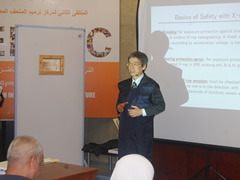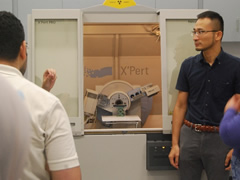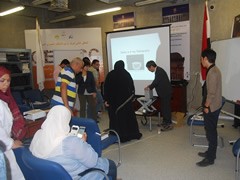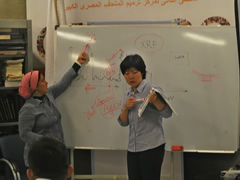- Home
- Technical Cooperation Projects
- Index of Countries
- Middle East
- Egypt
- The Project for the Conservation Center in the Grand Egyptian Museum
- Project News
- Diagnostic and Analytical Techniques for Conservation II Training course was held
Project News
2015-08-23
Diagnostic and Analytical Techniques for Conservation II Training course was held
At the Grand Egyptian Museum Conservation Center (GEM-CC), Japan International Cooperation Agency (JICA) conducted the training course on Diagnostic and Analytical Techniques for Conservation (session II) from 17th – 23rd August by inviting 3 experts in this field from Japan as listed below:
- Dr. Fumiyoshi Kirino: Professor, Conservation Science, Department of Conservation, Graduate school of fine Arts, Tokyo University of the Arts.
- Dr. Akira Fujisawa: Lecturer, Institute of Cultural Properties, Teikyo University.
- Dr. Mariya Masubuchi: Associate fellow, Japan Center for International Cooperation in Conservation, National Research Institute for Cultural Properties, Tokyo.
10 from the Conservation Center different labs members have participated in the course as main trainees, with an additional 7 members as observers.
The purpose and goal of the training course was to help trainees learn diagnostic/analytical knowledge and techniques of cultural heritages and to develop their professional abilities. They have to be able to make suitable selection of techniques and to be able to interpret the results of the analysis.
Also, to teach other practical subjects necessary for suitable diagnosis and analysis, because observation only cannot attain diagnostic and analytical results sufficiently. Enable the trainees to use necessary and integrated methods such as X-ray radiography, X-ray Fluorescence analysis (XRF) and X-ray diffraction analysis (XRD), and to obtain appropriate results according to their restoration and conservation purpose.
Firstly, trainees introduced a case study of their work which allowed the instructor to better understand their methods and ways so they can make the course content more relevant to them. Following that, as most of the trainees were not familiar with ionizing radiation Dr. Kirino gave a lecture on Safety in handling X-ray equipment introducing important precautions to take when dealing with equipment like XRF. He also explained how to manage using it in the laboratory showing the trainees how it's managed in his lab in Japan.
After trainees were taught how to use XRF and XRD, later on the same day, trainees were divided into two groups the first one practically practiced analyzing a sample with XRF with Dr. Kirino and Dr. Masubuchi while the other group practiced XRD analysis with Dr. Fujisawa and then switched the group to allow all trainees to practice XRF and XRD analysis.
Dr. Fujisawa gave a lecture on General knowledge in XRD and its application in conservation elaborating on the difficulties that face conservators in using XRD and also the benefits of using it. He also introduced different type of measurement of the same equipment to expand the trainees' general knowledge. Afterwards, the instructors showed the trainees how to interpret and analyze data, and started analyzing their analysis result data. Dr. Kirino finished the day with a final lecture introducing other instrumental analysis methods in conservation.
 Dr. Kirino showing trainees safety precautions when dealing with XRF
Dr. Kirino showing trainees safety precautions when dealing with XRF
 Dr. Fujisawa showing trainees how to use XRD
Dr. Fujisawa showing trainees how to use XRD
 Dr. Kirino showing Trainees how to use XRF
Dr. Kirino showing Trainees how to use XRF
 Dr. Masubuchi showing trainees how to interpret analytical data
Dr. Masubuchi showing trainees how to interpret analytical data
- About JICA
- News & Features
- Countries & Regions
- Our Work
- Thematic Issues
- Types of Assistance
- Partnerships with Other Development Partners
- Climate Change / Environmental and Social Considerations
- Evaluations
- Compliance and Anti-corruption
- Science and Technology Cooperation on Global Issues
- Research
- JICA Development Studies Program / JICA Chair
- Support for the Acceptance of Foreign HRs / Multicultural and Inclusive Community
- Publications
- Investor Relations
